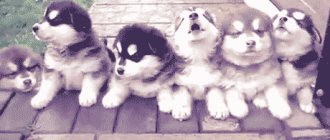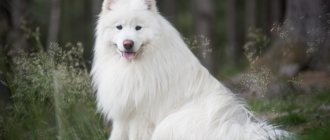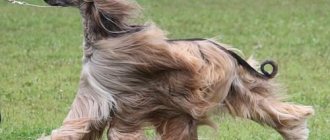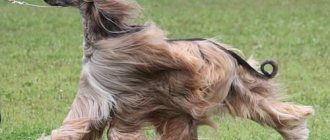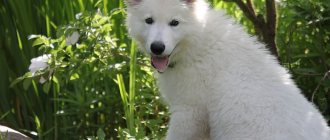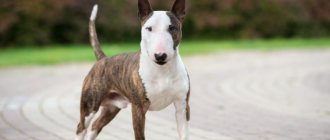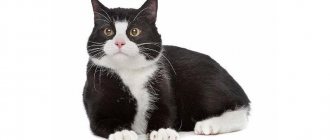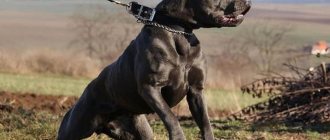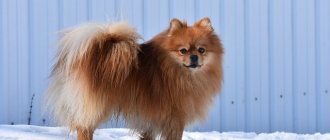In this article you will find information about brachycephalic (flat-faced) dog breeds, possible risks associated with their health, as well as information about the correct breeding of these animals.
Below is not only a list of dogs with flat faces, but also a description of their appearance, temperament, activity level, as well as susceptibility to any diseases.
List of brachycephalics
Dogs referred to by this term include:
- bulldogs (French and English) - originally bred as fighting dogs;
- pugs - created to warm a person;
- Pekingese;
- Dogues de Bordeaux;
- bullmastiffs;
- Boxers are also fighting dogs;
- Shar-Pei;
- Japanese Chin;
- chihuahua;
- Pomeranian Spitz, etc.
These breeds were specially bred through selection work aimed at obtaining and consolidating the desired trait - a short, flattened muzzle. But, unfortunately, the dogs received many additional health problems.
The respiratory tract in dogs with a flat face has undergone changes: the nostrils have narrowed, the soft palate has enlarged, defects in the formation of cartilage tissue and the trachea are common, the lacrimal canaliculi are meek or folded. All pets of these breeds are forced to make efforts during the breathing process in order to take a normal breath.
What breeds are brachycephalic?
Brachycephals have a shortened skull shape, which makes the dog's face look flat.
Brachycephalic breeds include:
- English, American and French bulldogs;
- Affenpinscher;
- Brussels Griffon;
- Dogue de Bordeaux;
- Japanese Chin;
- Cavalier King Charles Spaniel;
- chow-chow;
- Boston Terrier;
- bullmastiff;
- Shih Tzu;
- chihuahua;
- pug;
- brasileiro;
- Pekingese;
- Lhasa Apso;
- boxer.
Brachycephalic syndrome
This is the name for narrowing of the airways, which is of clinical significance. In the dog’s body, the nostrils, nasal passages are narrowed, the soft palate, on the contrary, is elongated, the larynx and trachea are deformed. The result is severe shortness of breath and wheezing. Symptoms worsen in hot weather, stress, and physical activity. The condition can lead to a severe lack of oxygen and even cause the animal to faint.
In dogs of brachycephalic breeds, due to respiratory failure, pulmonary pressure is often increased and cardiac pathologies occur. Pulmonary edema and airway obstruction are often diagnosed in these animals and often lead to sudden death, the cause of which is suffocation.
Is there a way out? Some veterinarians resort to plastic surgery, after which the dog’s condition improves.
What should you pay attention to?
The owner of a dog with a flat face should be aware of:
- How a dog breathes in the heat. Respiratory failure combined with overheating is a dangerous sign that can lead to irreparable consequences and even death.
- Do the animal's nostrils stick together when inhaling?
- Does the dog make sounds or groans when breathing?
- If your pet constantly snorts, sneezes, puffs, this is abnormal.
- While wearing a collar, the dog begins to cough. There is no point in causing suffering to your pet once again, but it is better to walk your dog on a harness.
- It is worth monitoring the animal’s weight and not allowing it to gain extra pounds.
Signs that require urgent veterinary attention
If the dog has a flat face, the owner should be constantly alert. Here are signs that require urgent attention to a veterinarian:
- loud wheezing when breathing;
- unnatural posture of the animal;
- rapid breathing;
- animal anxiety;
- pale or blue tongue, lips and gums;
- foam coming out of the mouth.
In all these cases, you should not give the dog water or medicine; you should provide air flow and urgently take the animal to the doctor.
Rules for owners of brachycephalic dogs
Owners of dogs belonging to the brachycephalic group must adhere to the following rules:
- Carefully observe your pet and especially its breathing. If an animal is breathing heavily with slight overheating or even the slightest physical exertion, then this is a reason to seek advice from a veterinarian. Timely medical care will help prevent the development of serious internal pathology.
- Inspect the animal’s nostrils, which should always be wide open (not closed when inhaling).
- Periodically listen to how the dog breathes and the sounds it makes. It is important to notice how often he sneezes, snorts or sniffles. Any uncharacteristic and suspicious sounds should alert you. A dog snoring in its sleep is not abnormal, but if it makes loud choking sounds, then this is already an alarming signal.
- Try not to use a regular dog collar, since when it is pulled, it tightens the trachea, and the animal begins to cough. It is better to use a harness that distributes the load more evenly.
- Keep your pet's weight under control. Excess weight will greatly aggravate the problem .
- Immediately take your dog to a medical facility if the following acute symptoms are present: changes in the color of the lips, tongue and gums to pale or bluish;
- foamy discharge from the mouth;
- loud convulsive wheezing when breathing;
- unnatural and abnormal posture (the front legs are too wide apart, the neck is elongated, etc.);
- anxiety (the dog is spinning and cannot find a place for itself);
- shortness of breath (rapid breathing) that does not go away for a long time.
Some airlines provide a special service for transporting dogs of brachycephalic breeds
Many airlines do not allow dogs of brachycephalic breeds to be carried on their aircraft. This is due to the deaths that have occurred with such animals. Pets experience severe stress from an unusual environment and being in a stuffy, confined space; in addition, when they gain altitude, a change in atmospheric pressure occurs. This causes labored and rapid breathing, then the body temperature rises and the heartbeat increases. After subsequent oxygen starvation, heart failure progresses sharply. The risk of death of the animal is very high.
A good friend of mine lives in Yakutia and constantly flies on vacation with her pug. Airlines usually do not prohibit this, because it is very difficult to get from there to the warm seas by other means of transport. There have never been any problems with the dog's health. Apparently, the degree of pathological changes can be different, so flying on airplanes is prohibited only in the most severe cases.
Other possible health problems
In addition to respiratory pathologies, dogs with a flat face also have other pathologies:
- Disturbances in the outflow of tear fluid. It happens that the eyes of such dogs constantly get wet. It may also be the other way around - the eyeball is not sufficiently moistened, especially if the organs of vision are enlarged.
- Dental diseases. Brachycephalics often have an incorrect bite, which is why plaque, tartar, and gingivitis appear.
- Excessive wrinkles on the face lead to the spread of fungal infection.
- Thermoregulation problems. Brachycephalics often suffer from excessive body temperature.
- Allergic reactions are by no means uncommon in dogs of the breeds in question. They manifest themselves in the form of skin rashes, as well as respiratory spasms.
- Tendency to gain excess weight. Dogs of brachycephalic breeds should not be overfed; excess weight can significantly worsen their health.
Flat-faced dogs
Brachycephalic dogs are one of the most popular dogs in the world. Below you will find information about these cute creatures and perhaps decide to choose a flat-faced pet as a new member of your family.
Pug
The Pug is one of the most recognizable brachycephalic breeds. These dogs are distinguished by their small size, large expressive eyes and specific color - white with dark areas around the ears and muzzle.
Without a doubt, what the pug lacks in size it more than makes up for in character, so it’s easy to understand why so many people fall in love with this flat-faced creature.
Pugs are not very energetic, although they are happy to get involved in the proposed game or go for a walk together. However, being lazy by nature, these guys are prone to gaining excess weight.
Like other brachycephals, representatives of this breed have difficulty breathing and do not tolerate hot climates.
Boxer
Large and very active, the Boxer is an ideal choice for energetic families. He is suitable for the role of a guard dog and shows incredible devotion to those close to him. However, sometimes Boxer owners can catch their pets doing uncontrollable, stupid things.
Most representatives of the breed are tan in color, but white and brindle colors are also found; All Boxers are characterized by a white patch running down to the chest.
Overly active dogs need plenty of exercise. Without exercise, Boxers will seek out entertainment of their own accord and their energy can be destructive.
Many representatives of the breed snore and have some difficulty breathing, but these problems are not too pronounced in Boxers.
French Bulldog
Representatives of one of the most popular breeds combine a charming appearance and a pleasant character. They charm with their large erect ears, wide-set eyes, short legs and wrinkled forehead.
French Bulldogs that aren't too energetic need only one long walk a day and don't need much exercise. Representatives of the breed are characterized by curiosity. They are also often found in competitions requiring qualities such as agility and obedience.
The structure of the French Bulldog's skull leaves a big imprint on its breathing, causing snoring and problems during physical activity.
English bulldog
The English Bulldog, although not the tallest dog, has a rather stately and menacing appearance. According to the AKC (American Kennel Club), it is one of the top five most popular breeds in the United States.
This dog is friendly, easy to care for due to its short hair and is ideal for people leading a sedentary lifestyle. She loves to please her owner and is obedient if started at an early age.
Relaxed and leisurely, English Bulldogs tend to gain excess weight, and therefore need regular training and proper nutrition.
American Bulldog
Many people think that American Bulldogs do not suffer from structural features of the skull, but, unfortunately, this opinion is wrong. These dogs have health problems, but not as severe as their French and English counterparts.
Large American Bulldogs are full of energy and, having been working dogs in the past, display advanced physical and mental abilities.
Representatives of the breed are somewhat reserved, so it is important to begin the training process at an early age and constantly adhere to established rules and boundaries; This is the only way to get a well-mannered furry family member.
While most brachycephals do not have high energy levels, the American Bulldog is overly active and this exacerbates breathing problems. Owners of such dogs should be attentive and constantly monitor the condition of their pet.
Neopolitan Mastiff
A distinctive feature of the Neopolitan Mastiff is its “sad face.” This dog is also known as a professional guard, which is helped by its appearance that repels intruders.
Representatives of the breed are sensitive natures, so their training should take place in a calm environment; rudeness can upset the animal and throw it out of balance.
Despite their impressive size, Neopolitan Mastiffs do not have high energy levels. During the daytime, they can often be found napping rather than running around the yard. For a dog to fully develop and be healthy, it needs physical exercise; One long walk a day will be enough.
Having a shortened muzzle and a lot of wrinkles, the breed can nevertheless cope with difficulties associated with breathing.
Boston Terrier
The small but powerful Boston Terrier has a bright and dazzling look, a pleasant character and developed learning abilities.
Thanks to the specific color, which gives the impression of wearing a tuxedo, the dogs are easy to distinguish in a crowd and, perhaps, this is the reason why representatives of the breed often end up as characters in films. This prominent brachycephalic figure appears in films such as Plan B, Valentine's Day and Hotel for Dogs.
The easy-to-train Boston Terrier is eager to please its owner and performs best when given treats.
Due to their flat muzzle, the breed is prone to overheating during the summer months, so owners should choose the right time of day to walk their pet. You also need to make sure that the dog can always find shade and has access to water.
Shih Tzu
The Shih Tzu is a dog with pronounced flowing curls. Her “fur coat” is so impressive that her flat muzzle often fades into the background.
The Shih Tzu's coat requires a lot of attention. She needs regular care, both at home and when visiting a groomer (the latter can correctly assess the condition of the “fur coat”).
The breed's energy level is low, so one walk a day is enough for them. For this same reason, Shih Tzus can often be seen as companions for older people, although these dogs are also suitable for family life.
Shih Tzus suffer from underdeveloped nostrils and trachea, which causes breathing problems. For this reason, it is vital to take proper care of your pet's coat to avoid matting that can interfere with breathing.
Pekingese
The Pekingese is an ancient breed bred in China for the upper classes; It is not surprising that its name translates as “lion dog.”
Thanks to its thick two-layer coat, the Pekingese, even with its small stature (only 15-23 cm), stands out among other dogs. However, its unusual “fur coat,” which is prone to tangling, requires regular care.
The leisurely Pekingese with the personality of a royal person loves to walk and play, but does so in his own relaxed manner.
Along with difficulty breathing, the breed may have vision problems due to accumulation of skin around the eyes.
Affenpinscher
Coarse fur, small eyes, a wary facial expression, and a muzzle reminiscent of the Star Wars character Wookiee make the Affenpinscher so attractive that it is difficult not to fall in love with him.
The cheeky and at the same time charming baby has a unique story. In former times, it was used as a multifunctional dog, which caught rats during the day and kept its owners warm at night, lying in the same bed with them.
Representatives of the breed have an average level of energy and feel comfortable both in an apartment and in a country house. During the learning process, they quickly lose interest, so training should be short and include rewards in the form of treats.
Breathing difficulties occur in Affenpinschers mainly in hot weather; Living in a cool climate relieves dogs of these problems.
Shar Pei
The most wrinkled dog often causes bewilderment - others consider the sharpei's unique appearance, its coarse fur, and also its reserve towards strangers strange. However, if you look closely, you begin to fall in love with this loyal, regal and intellectually developed dog.
The Shar Pei's special coat, which feels like rough corduroy, requires virtually no grooming. However, this does not relieve the owner of worries, because... representatives of the breed have a specific structure of the ear canals: due to their narrowness, pets suffer from ear infections more often than other pets. This feature requires regular hygiene procedures.
Shar Peis easily adapt to their owners and can lead both a sedentary lifestyle and enjoy active activities.
Sometimes breathing difficulties in these dogs force owners to reduce their exercise; in this case, so that the intellectually developed Shar Pei does not get bored, it is recommended to offer mental training in return.
Dogue de Bordeaux
The Dogue de Bordeaux is one of the most famous flat-faced dogs, which many became familiar with after watching the movie “Turner and Hooch” starring Tom Hanks. Thanks to the film, people were able to understand what flat-faced pets are and what special features they have.
The bright red color, wide-set and very expressive eyes, as well as the wrinkled muzzle make the Dogue de Bordeaux especially attractive. However, according to the American Kennel Club, the breed ranks only 67th in the ranking of breed popularity among US residents.
This dog has one noticeable flaw - excessive salivation, although their loyal and loving nature makes it less noticeable.
The Dogue de Bordeaux, often called the gentle giant, has a calm character, making it suitable for families with children.
Due to their flat muzzle and excess skin around the nose, the breed is prone to breathing difficulties; therefore, hot climatic conditions are not suitable for them to live in.
Reverse sneezing
This phenomenon is often observed in brachycephalic dogs. It looks like this. The dog spreads its front legs, tenses, and makes a series of snorting sounds for a minute. After the attack he behaves as usual. It could also be different: the dog inhales, makes a loud sound and freezes, stretching his neck.
Such sneezing can be caused by strong odors, emotional reactions, and dust getting into the nose. It is not a pathology, and its features are caused by the specific structure of the muzzle. But such a phenomenon should be distinguished from brachycephalic syndrome, and therefore it makes sense to film the attack and show it to the veterinarian. As a rule, no additional measures are required during an attack; the sneezing goes away on its own.
Air travel ban
Owners of the dogs in question may be faced with the fact that their pet will not be taken on board the plane, and will also not be allowed into a special compartment for transporting animals. This is due to the frequent death of such animals during flight. Stress and changes in pressure trigger the mechanism of acute respiratory failure in a dog. Therefore, you should not be upset because of the ban, but it is better not to risk the life of the animal and leave it with relatives or friends for a couple of weeks. This way you can save the dog's life.
Let's take a closer look at some brachycephalic dog breeds and their characteristics.
Pekingese
A breed considered sacred in Ancient China. It is suitable for an inexperienced breeder, but families with small children should not take the dog, as the child can injure the animal.
Pekingese puppies are almost impossible to train due to their stubborn nature. The dog barks often, and for no apparent reason. This feature is also worth considering, especially if you decide to get a Pekingese puppy in an ordinary city apartment.
The advantages of the breed are longevity and cleanliness. Difficulties include caring for the coat and difficulty getting along with family members and other animals.
Proper care
The life expectancy and health of a pet with special proportions depends entirely on the conditions of detention. A balanced diet combined with physical activity will help you avoid unnecessary risks. Each breed has its own characteristics of caring for the coat, teeth and ears. But there is a set of general rules and contraindications for dog breeds with short legs:
- Climbing and descending steep stairs is not recommended;
- table feeding;
- jumping from high surfaces;
- The absence of daily walks in the fresh air is unacceptable.
The main problem of such animals is considered to be increased stress on the spine. Therefore, being overweight is a cause of serious illness for them.
Short-legged breeds have been bred for centuries and used as hunters and rat catchers. They went with them to hunt for game, took them on voyages, and entrusted them with herding herds. Over time, these abilities lost their relevance, which allowed funny animals to become true friends and companions.
Pugs
This small, flat-faced dog is a sweet, low-maintenance pet. The pet spends most of its time sleeping. The dog is sociable, playful, loyal to its owner, but sometimes stubborn. You can have a pug in the family. where there are small children. The dog is loyal to children's pranks, sometimes turning into a cute soft toy.
Caring for a pet is easy. It is important to wipe the fur daily; the pug’s eyes are treated with a cotton swab dipped in tea leaves. The nasal folds are treated with cotton pads soaked in alcohol-free baby lotion. You can bathe your dog 1-2 times a month.
French Bulldog
This breed is a smaller version of the English Bulldog. The dog is muscular, initially it was bred to participate in battles, but later it was classified as an ornamental breed. By nature, the pet is cheerful and cheerful.
Features of the French Bulldog breed are:
- Calm disposition, lack of fear.
- They cannot stand loneliness and need constant communication with their owner.
- Requires minimal grooming (hair brushing and infrequent washing).
- Stubbornness, due to which one should not expect success in training.
Brachycephalic dog breeds
Despite the same muzzle structure, brachycephalic dogs differ from each other in size and character. Thanks to this, you can easily choose a pet for yourself, based on your housing options and preferences.
NOTE!
Carrying brachycephalic breeds on board an aircraft is strictly prohibited, as the pressure drop during flight can be fatal to them.
English bulldog
A close relative of the ferocious Old English Bulldogs, which were used for bloody fights with bulls and other animals in the 17th-19th centuries. The “Englishman” differs from its ancestors in its more modest dimensions, shortened jaw and unusually calm and devoted character.
“ All about the English Bulldog
French Bulldog
Modern “Frenchies” are the result of crossing English bulldogs with pugs and terriers. These dogs are famous for their playfulness and friendliness. They get along well with other pets and cannot stand being alone.
“ All about the French Bulldog
American Bulldog
Ambuli are modernized Old English bulldogs brought by colonists to the USA. At first they were used exclusively for protection from Indian tribes, so when breeding the main emphasis was on size and strength.
Unlike English and French bulldogs, American bulldogs are more wary of strangers. This makes them excellent watchdogs and bodyguards.
“ All about the American Bulldog
Boston Terrier
They were bred by crossing an English Bulldog and an English Terrier. From the first parent, the animals inherited a flattened muzzle, and from the second, the absence of the typical bulldog stockiness and folds on the muzzle.
Boston Terriers are the epitome of loyalty and friendliness. They easily make new acquaintances and can become wonderful friends even with feathered pets.
“ All about the Boston Terrier
Affenpinscher
The shaggy four-legged animals from Germany are former rat catchers who have retrained as companions after gradually decreasing in size to 4-6 kg. Affenpinschers idolize their owners and hate competition. Because of this, they do not get along well with other pets and do not favor children who encroach on their toys.
“ All about the Affenpinscher
Shih Tzu
Four-legged beauties with satin fur have long been exclusively court pets. During the Chinese Empire, their unauthorized sale and theft were punishable by death.
Shih Tzus are very sociable and friendly dogs, popular among retirees. They easily make contact with strangers and love to sit on laps.
“ All about Shih Tzu
King Charles Spaniel
Modern representatives of the breed appeared as a result of crossing with bug-eyed pugs and Japanese chins. By nature, these dogs are typical companions. They are devoid of aggression, get along well in an apartment, quickly get accustomed to a diaper and become very attached to their owners.
Pekingese
Despite their long history, the world learned about the Pekingese only in the 18th century. Until this moment, fluffy dogs were the main favorites of the Chinese emperor, and the right to breed them was inherited among members of the royal family.
Pekingese hate fuss and change. They are independent and do not depend on human attention. Thanks to this, four-legged animals are suitable for the elderly and workaholics.
“ All about the Pekingese
Brussels Griffon
A funny bearded man from Belgium is a direct descendant of the Affenpinscher. Despite its stern appearance, the Brussels Griffon is an energetic and sociable four-legged dog that loves to be the center of attention. When communicating with children, he is not known for his patience, so friendship with children is possible only if he is treated with care.
“ All about the Brussels Griffon
Belgian Griffon
Appeared during the Renaissance. At first, the Belgian Griffon was bred exclusively for catching rats, but its amusing appearance very quickly interested the European nobility.
This playful four-legged dog is completely conflict-free and easily finds language with other pets. He has a hard time with loneliness and is in dire need of constant company.
Petit Brabançon
It belongs to the European griffons, but differs from them in its smooth coat. Affenpinschers and Cavalier King Charles spaniels were used in breeding this breed.
The Petit Brabançon is an open and sociable pet that highly values human attention. Notable for his high intelligence and fearlessness.
“ All about Petit Brabançon
Pug
The Pug is another Chinese dog that was previously popular among Tibetan monks and nobility. It is characterized by playfulness, friendliness and strong affection for humans. He easily makes contact with strangers and is famous for his balanced character.
“ All about the pug
Boxer
It was developed by crossing mastiffs, bulldogs and bullenbeisers. Initially it was used for hunting, transporting goods and grazing livestock.
The Boxer retains protective and guard qualities until old age. Due to his balanced character, he is often invited to work with blind people as a guide.
“ All about the boxer
Japanese Chin
According to one theory, it was brought to Europe from China. Like the Shih Tzu, the Japanese Chin has long been popular with aristocrats and clergy.
Despite their modest size, representatives of this breed are unusually fearless and reckless. They never retreat before a larger enemy and, in case of danger, defend their masters to the end.
“ All about the Japanese Chin
Chow chow
One of the oldest breeds of brachycephalic dogs, famous for its purple tongue and philosophical outlook on life. Chow chows are very restrained in expressing their feelings and recognize only one person as their owner.
“ All about chow-chow
Shar Pei
Like the Chow Chow, the Shar Pei is one of the most ancient four-legged animals. Its genotype is as close as possible to that of a wolf, which explains its developed pack instincts and tendency to dominate. Doesn't get along well with other pets and can't stand rude treatment even from children.
“ All about Shar Pei
Dogue de Bordeaux
According to one of the popular versions, it originated from fighting dogs. He does not tolerate loneliness well and is completely devoted to his family. During a walk, the Dogue de Bordeaux never strays too far from its owner, trying to keep him in its line of sight.
“ All about Dogue de Bordeaux
Neapolitan Mastiff
A close relative of the Cane Corso, bred from the fighting dogs of Roman legionnaires. Tends to be dominant over other dogs and does not trust strangers. Very jealous, but also unusually friendly towards the owner.
“ All about the Neapolitan Mastiff
Bullmastiff
It was bred to catch poachers at the turn of the 17th-18th centuries, so when breeding the main emphasis was on speed, viciousness and grip strength. At the beginning of the 20th century, the bullmastiff began to be recruited for service in the police and army.
At home, this dog loves to play pranks and fool around. He is patient with children and does not pose a threat to other pets. Despite the innate suspicion of strangers, the bullmastiff always listens to its owner and never attacks without receiving an appropriate signal.
Lhasa apso
Glamorous beauties from Tibet were bred by local monks and came to the Old World only towards the end of the 19th century. It was there that they were finally separated from the Tibetan terriers, which are distinguished by their larger dimensions.
Lhasa Apsos have a developed possessive instinct. Because of this, they often conflict with children who try to take their ball away or occupy their favorite sofa.
“ All about Lhasa Apso
Do you like the article? 0
Dogue de Bordeaux
This is a large animal with long hair. These dogs are also called French Mastiffs. The animal looks scary, but has a calm disposition. They have a well-developed intellect and excellent memory.
Breed Features:
- Excellent security qualities.
- I am ready to stand up for my own people to the death.
- It can show aggression towards “strangers”, but more often it frightens by barking. He can throw it only as a response.
- They get along well with other dogs, but are intolerant of other people's pets and can be aggressive.
The dog is intended to protect family members, and not the local area, so it can easily live in an apartment, but it is worth considering its rather large size.
Grooming includes combing the fur, trimming the claws, and regularly examining the eyes and ears. Frequent bathing is not required; the procedure can be replaced with dry cleaning.
Shar Pei
A dog distinguished from other breeds by a large number of skin folds. Shar Peis have a sense of self-esteem and do not bother the owner with the need for careful grooming. The only thing that the owner should take into account is the dog’s need for long and frequent walks to maintain its muscle corset.
The pet is squeamish about water, and therefore it is not worth bathing it often.
The characteristics of the breed are:
- Balanced character.
- Loyalty to the owner.
- Security qualities.
- Cleanliness.
Dog experts call willfulness of character, aggression towards other animals, and health problems in the form of allergic reactions as disadvantages.
What does the term “brachycephalic dog breed” mean?
Based on the appearance of the skulls of dogs, they are divided into brachycephalic, dolichocephalic and mesocephalic. The last group is the most numerous. It includes 75% of existing breeds that are distinguished by moderate muzzle proportions. The remaining 25% are divided into flat-snouted brachycephals and long-snouted dolichocephals.
REFERENCE!
Brachycephaly, or short-headedness in animals, is the result of painstaking selection. The first owners of a shortened muzzle with a flattened nose were fighting dogs from England and court dogs from Ancient China.
Despite their touching appearance, all flat-faced dogs have serious health problems. Due to the extremely short nasal passages and disproportionately long soft palate, their breathing is difficult even at rest.

